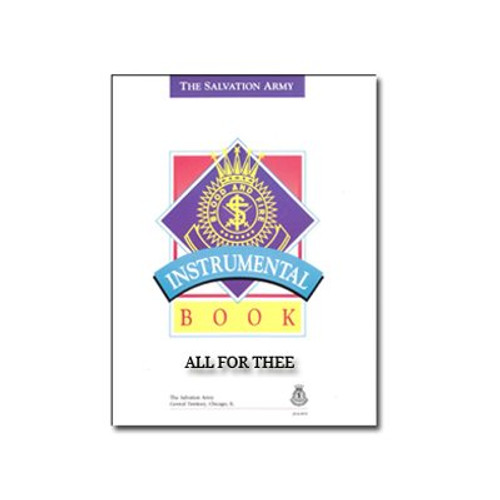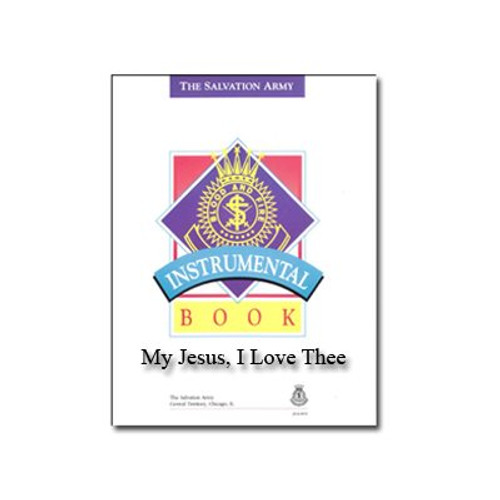Product Description
All of Thee
Meditation
Composer: William Gordon
Produced by The Salvation Army - Central Territory
Score Sample
NotesThis is a digital product. After purchasing you'll be able to download it from Account -> Orders -> Select order number
Score Notes
Notes:
Comments by Staff Bandmaster William Himes, Music & Gospel Arts Secretary, USA Central TerritoryThe composer has fully exploited the many timbres and intensities of the brass band in this introspective work. The conductor would be well served to study the words to the song which is the unifying theme, "O the bitter shame and sorrow'' (SA Song Book #548).While there are few technical challenges, pacing and endurance is key to successful performance. Therefore be careful to keep forte (f) passages in proportion so that the two fortissimo (ff) moments (bars 111-112 and 137-138) stand out by comparison.Bars 11-34: Strive for clarity and flow as the melody is transferred through various sections - even a bass trio at 27-34.Bars 37-67: Note the unusual indication of meno mosso ed agitato (less motion and agitated.) This is best achieved through the incessant ostinato of eighth notes (quavers) in percussion, basses and later, horns and baritones.Bars 68-92: The nonspecific increase in tempo (piu mosso) is no doubt intended to be slight. At the least, it should be a few points above the opening and closing tempo (80). Strive for warm sonority in this chorale section.Bars 93-98: An undercurrent of rolling triplets foreshadow the triumph and freedom conveyed in the final section to come. It should be flowing yet rhythmic.Bars 99-end: This section portrays the exhilaration and freedom of complete surrender as expressed in the song's final verse ("Lord, thy love at last has conquered"). Again, strive for a sound that is warm and intense as opposed to brazen and forceful. The diminuendo into 115 allows for an extended build as the phrase, "None of self and all of thee!" repeats several times. Note in the final bar the low brass release at beat 3, leaving a shimmering fortissimo chord in the cornets, horns, baritones and trombones.?Program Note: The song of Theodore Monod (1836-1921), "None of self," chronicles a spiritual journey in four verses in which the final line of each reflects a progression of God's presence:All of self and none of thee!Some of self and some of thee!Less of self and more of thee!None of self and all of thee!
Program Note:
This colorful selection uses three songs of contrasting idiom to portray a progression of the human condition from despair to triumph:
Although this is a more extended work (approximate duration: 9:00), the inclusion of optional introductions and endings provides added usefulness of presenting singular performances of these three songs as follows:
Sometimes I feel like a motherless child: Beginning to optional ending at bars 39-40.
Reach out and touch: Bar 42 to optional ending at bars 110-113.
Storm the forts of darkness: Begin with snare drum roll (can be a pause) one beat before 117. Play to end as written.
Program Note:
This beautiful setting for solo trombones and band of the folk song O Waly, O Waly is often associated with the words of Isaac Watts:Note to the Conductor:
We are pleased to present this sensitive setting as it was initially conceived for solo trombone. Written for the Amsterdam Staff Band's 2005 tour of the United Kingdom, it was later adapted as a feature for trombone ensemble, at the request of Salvationist Publishing & Supplies, where it appears in 2009 as General Series 2059.
We are grateful to SP&S for kindly giving permission to publish this solo version in the American Festival Series. Of this work, the arranger, Olaf Ritman writes: "I consider this song my personal testimony."
Beginning to bar 12: The accompaniment, particularly at the opening and closing of the piece, is atmospheric, with suspended muted chords supporting the rubato trombone solo. The judicious use of percussion (chimes, bass drum and suspended cymbal) will add to the color and mood. Be sure to cue the chimes at bars 3 and 6.
at bar 4, a clear downbeat cure for the bass drum will help clarify tempo following the soloist's pause. Also give attention to the muted sforzando in cornets and trombones in bar 8.
Bars 13-52: Following the ritardando at bar 12, it is essential for the conductor to establish the correct tempo at bar 13, allowing the soloist lyrical freedom and the ability to sustain long phrases as the tune begins at bar 16. The descending scale gesture at bar 39 should be measured, yet not overstated.
Bars 53-74: There is a slight slowing of tempo as soprano, flugel and horns take the theme while cornets, trombones and euphonium adding countermelody.
Bars 75 to end: Returning to the opening tempo, it will again be helpful to give clear cues for the chimes, bass drum and triangle from bars 75 to the end.
[Note: This solo can be heard on the Chicago Staff Band recording,Kurios, performed by Brett Tolcher]
Program Note:
The tune Randolph, by preeminent English composer Ralph Vaughan Williams was first published in 1906 as a setting of Jeremiah Rankin's hymn, of which the first verse reads:
Note to the Conductor:
William Gordon's stunning four verse setting of Randolph progresses from the quiet simplicity of unison cornets and with each succeeding verse builds to a magnificent organ-like finale.
Gratitude is expressed to the publisher and copyright holder, Oxford University Press, for granting permission to publish this brass setting in the American Festival Series.
Beginning to bar 9: A ceremonial snare drum roll is the sole accompaniment to the cornets opening unison rendering of the tune.
Bar 10-17: The mellow instruments (flugel, horns, baritones and euphoniums) provide a beautiful change of color here with 2nd horn, baritones and euphonium seamlessly adding harmony.
Bars 18-26: A two beat snare and bass drum roll signals the entrance of the cornets and trombones in a more brilliant third verse setting. Here the bass trombone is essential (cued in Eb bass). Bring out the rising soprano cornet line from bar 22.
Bar 27 to end: A dramatic percussion roll precedes the "open pipes" organ like sounds of the final verse at bar 27. Be sure to observe the swell in bar 30, followed by a dramatic decrescendo before building to the final climatic chords. Avoid any tendency to overblow while striving for the full sonorities of this majestic finale.
[Note: this setting is especially effective when performed as a benediction "in the round" with players grouped by sections surrounding the audience.]







